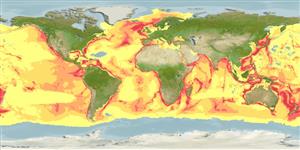Common names from other countries
Classification / Names / Names
Namen | Synonyme | Catalog of Fishes (gen., sp.) | ITIS | CoL | WoRMS
Environment: milieu / climate zone / depth range / distribution range
Ökologie
Pelagisch; ozeanodrom (Ref. 75906); brackwasser; tiefenbereich 0 - 3510 m (Ref. 116169). Tropical; 13°C - 28°C (Ref. 75906); 90°N - 90°S, 180°W - 180°E
Atlantic, the Mediterranean, Indo-Pacific and the Antarctic. Tropical to temperate.
Length at first maturity / Size / Gewicht / Alter
Maturity: Lm ? range ? - ? cm Max length : 380 cm TL Männchen/unbestimmt; (Ref. 1394); max. veröff. Gewicht: 500.0 kg (Ref. 1394)
Inhabits deep oceanic and continental slope waters of the tropics through the temperate regions in both hemispheres. Feeds os (Ref. 1394). Feeds in deeper waters (Ref. 122680) on crustaceans and cephalopods, but prefers squid (Ref. 1394).
Breeding is year-round.
Tan, J.M.L. 1995. (Ref. 936)
IUCN Rote Liste Status (Ref. 130435)
CITES Status (Ref. 108899)
Nutzung durch Menschen
Fischereien: kommerziell
FAO - Fischereien: landings, Artbeschreibung | FishSource | Sea Around Us
Tools
Internet Quellen
Estimates based on models
Preferred temperature
(Ref.
115969): 4.2 - 15.7, mean 8.7 (based on 2801 cells).
Widerstandsfähigkeit
hoch, Verdopplung der Population dauert weniger als 15 Monate. (K=0.49-0.57; tm=11).
Verwundbarkeit
Moderate vulnerability (41 of 100).
Preiskategorie
Unknown.
